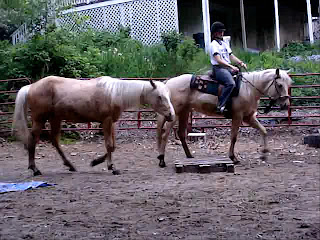THEORY AND METHOD
I like to hold of on riding in the saddle, as I mentioned before, until I'm pretty confident that my colt isn't going to overreact to my being up on his back. When I am bareback, I just find that I can get out of the way faster, if need be, and in addition, have a better feel of what the colt is going to do before he does it.
Since the colt has already been introduced to a saddle (as well as been sacked out, worked with a flank rope, surcingle, and been ridden!) this isn't a big deal. Just warm your colt up by reviewing the groundwork basics he's learned so far. I usually just make sure I can send the colt forward, disengage his hips, move his shoulders, and back him up. I might check lateral flexion and vertical flexion, move his head up and down, or flex him by the ears if the mood strikes me. I don't want the colt tired, just in a good state of mind. If the colt is tired, he isn't going to want to move, and forward motion is key to training.
After I saddle up, I will probably spend a few more minutes doing ground work to remind the colt what a saddle feels like when he's moving around with it. Shake the saddle around a bit, slap the fenders, make some noise to see how he will respond. If all goes well, then we'll move on.
As with all horses, be safe when you mount. Tip the colts nose around towards you a bit. Place just your toe in the stirrup, and step up politely. Try not to drag on the saddle; instead, move smoothly and quietly. I step up half way, rest my hip on the saddle and scratch the colt a while before stepping all the way up. Smoothly, without jabbing your colt, put your other foot into the offside stirrup (it's nice, especially in situations like this, to have your stirrups turned on your saddle. You can either do the traditional stirrup twist and hold it steady with a broom stick, or have a saddle shop pre-turn your stirrups for you).
Once I'm up on the colt, I basically just put another first ride on him. Work on getting forward motion, flexing left and right, and making circles. I personally, from this point out, continue to ride the colt bareback for a while longer. I'll work in the saddle now and then to keep him used to it, but prefer to do most of my breaking bareback.
Please use caution and common sense. Horses are large animals, with an exceptional amount of power and strength. They are also concerned above all with their own personal safety, and will do whatever they feel it takes to keep themselves from harm. Being individuals that act and react differently, the only certainty you have when working a horse is uncertainty. I am a professional trainer with twenty plus years experience, yet even with the knowledge I possess, I still get hurt from time to time. This blog and the accompanying media are for entertainment purposes only. No responsibility will be assumed for injuries or damages incurred while trying to use these methods at home. Please ride responsibly; protective gear can save your life!
 Stevie relaxing on the bridge, with my "assistant", Nick, a three year old colt. I like to have lots of distractions for my colts when I am working, and a loose horse in the ring is certainly one!
Stevie relaxing on the bridge, with my "assistant", Nick, a three year old colt. I like to have lots of distractions for my colts when I am working, and a loose horse in the ring is certainly one!






